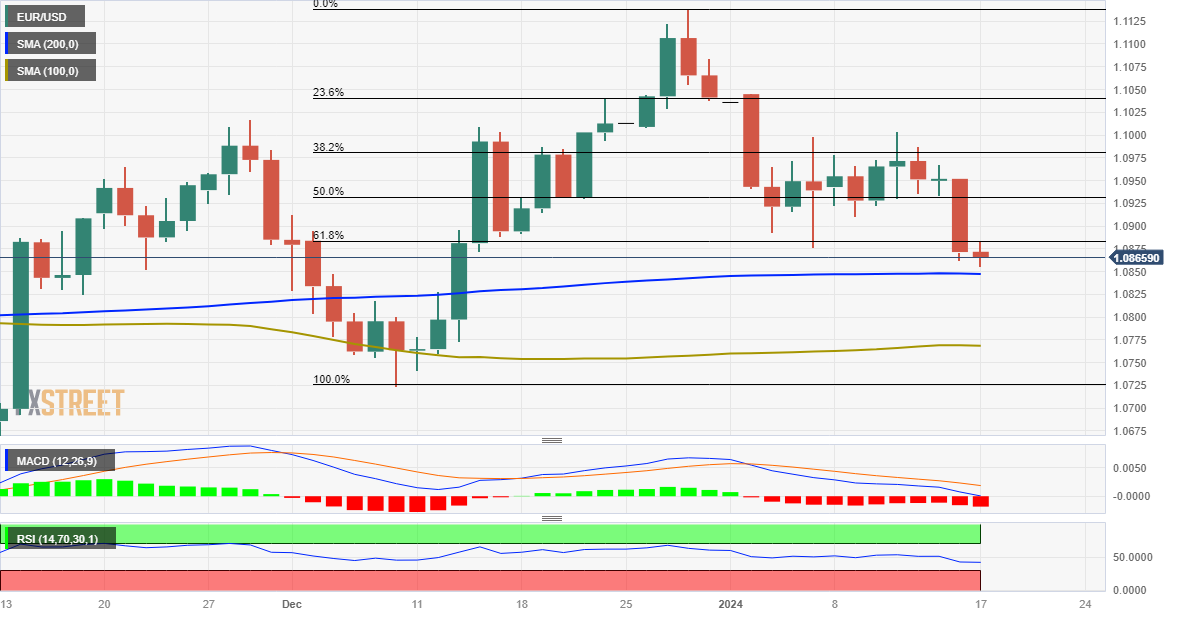- EUR/USD drops to over a one-month low on Wednesday amid some follow-through USD buying.
- Reduced bets for a March Fed rate cut act as a tailwind for the US bond yields and the Greenback.
- Mixed signals from ECB policymakers fail to impress the Euro bulls or lend support to the major.
The EUR/USD pair remains under some selling pressure for the second straight day on Wednesday and drops to its lowest level since December 13, closer to mid-1.0800s, or the 200-day Simple Moving Average (SMA) during the early European session. The US Dollar (USD) builds on this week’s breakout momentum through a short-term trading range and jumps to over a one-month peak, which, in turn, is seen as a key factor weighing on the major.
Federal Reserve (Fed) Governor Christopher Waller said on Tuesday that the US central bank will not rush to cut policy rates until it is clear that lower inflation will be sustained. The comments forced investors to further push back their expectations for a more aggressive policy easing and remain supportive of elevated US Treasury bond yields. In fact, the yield on the benchmark 10-year US government bond holds steady above the 4.0% threshold, which, along with a generally weaker risk tone, is seen underpinning the safe-haven Greenback.
Reduced bets for an early interest rate cut by the Fed, along with an escalation of military action in the Middle East and rather unimpressive Chinese macro data, temper investors’ appetite for riskier assets. In the latest development, the US carried out another airstrike targeting a Houthi missile facility in Yemen amid a threat to merchant vessels and US Navy ships in the Red Sea. Meanwhile, the official data released by the National Bureau of Statistics (NBS) showed that China’s economy expanded at an annual rate of 5.2% in the final quarter of 2023.
China’s GDP growth was above the government’s 5% target for 2023, though was driven by a lower base for comparison from 2022. On a quarterly basis, Chinese GDP expanded by 1.0% in Q3, as expected. Following the release, the NBS noted that China’s economy faces a complex external environment and low consumer prices reflect insufficient domestic demand. Other data showed that China’s Retail Sales and Industrial Production rose by 7.4% YoY and 6.8% YoY, respectively, in December, though did little to fuel any optimism or boost the broader risk sentiment.
Adding to this, mixed views on inflation and interest rates by the European Central Bank (ECB) policymakers turn out to be another factor weighing on the shared currency, contributing to the offered tone around the EUR/USD pair. Bundesbank President Joachim Nagel said on Monday that it is too early for the ECB to discuss cutting interest rates as inflation remains high. In contrast, ECB Governing Council Member Tuomas Valimaki on Tuesday signalled his openness to consider lowering interest rates sooner than most of his colleagues.
Furthermore, Portuguese central bank chief Mario Centeno said that a rate cut should be part of the discussion and no option should be taken off the table. Moreover, an ECB survey on Tuesday showed that Eurozone consumers have slashed their inflation expectations and see prices to grow by 3.2% in the following 12 months, down from 4.0% a month earlier. Adding to this, expectations for inflation three years ahead also came down to 2.2% from 2.5%. This fails to assist the Euro to attract any buyers or lend support to the EUR/USD pair.
Moving ahead, traders now look to the release of the final Eurozone CPI print for some impetus. Meanwhile, the US economic docket features the release of monthly Retail Sales and Industrial Production figures later during the early North American session. This, along with scheduled speeches by Fed Governors Michael Barr and Michelle Bowman, the US bond yields and the broader market risk sentiment, will influence the USD price dynamics and contribute to producing short-term trading opportunities around the EUR/USD pair.
Technical Outlook
From a technical perspective, spot prices already seem to have found acceptance below the 61.8% Fibonacci retracement level of the December move-up. Given that oscillators on the daily chart have just started gaining negative traction, some follow-through selling below the 200-day SMA, currently around mid-1.0800s, will be seen as a fresh trigger for bearish traders. The EUR/USD pair might then accelerate the fall further towards the 100-day SMA, around the 1.0765 region, before aiming to challenge the December swing low, near the 1.0725-1.0720 area. This is closely followed by the 1.0700 mark, which if broken decisively should pave the way for an extension of the recent corrective decline from a multi-month peak touched in December.
On the flip side, the 1.0900 round figure now seems to act as an immediate barrier ahead of the 1.0920 horizontal zone, representing a nearly two-week-old trading range support breakpoint. Any further recovery is more likely to attract fresh sellers and remain capped near the 1.0970-1.0975 supply zone. The latter should act as a key pivotal point, which if cleared decisively might trigger a short-covering rally. The subsequent strength has the potential to lift the EUR/USD pair beyond the 1.1000 psychological mark, towards the next relevant hurdle near the 1.1060 area. The momentum could extend further towards the 1.1100 mark en route to the multi-month peak, around the 1.1135-1.1140 region.
EUR/USD daily chart






